Attached toilets: features, types and installation

Modern plumbing has long gone beyond standard functionality and design. Today, the toilet should be not only comfortable, but also aesthetically pleasing, and fit well into the design of the bathroom. In small rooms, the size of the structure is of great importance. Attachable toilets combine all the advantages of floor-standing and suspended systems. They are compact, reliable, and the budget ranges from economy to premium models. The choice of an attached toilet is a very responsible matter, it is necessary to take into account a number of points that can both simplify and complicate life.



What it is?
A side-mounted toilet with a hidden cistern belongs to the floor-standing type. It is also called wall-mounted, since the installation takes place close to the wall, without gaps. The bowl rests on a stand, making up a single whole with it. In fact, this design is a built-in toilet bowl supported on the floor, that is, a combination of traditional and wall-hung toilet bowls. This type is functional and ensures good hygiene. Ideal for a small toilet.
This system hides from view:
- drain type pipes:
- siphons;
- drain tank;
- all sewerage and water supply communications.


The attachment has a huge advantage over the suspension system in terms of installation. There is no need to use complex installations, frames to hold the structure on the wall... This significantly saves installation time, reduces complexity and saves money. The tank is hidden behind a false wall, where the cold water supply is located. Sewer pipes are connected separately, but also hidden behind the wall.
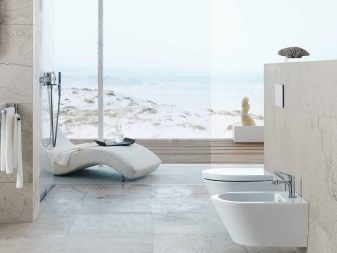

Advantages and disadvantages
This design has a lot of advantages, such a plumbing system allows:
- do not clutter up a small space with large plumbing equipment, in comparison with a floor-standing toilet, the attached one is shortened, which means it takes up little space;
- create a flawless, spectacular bathroom design;
- make the room visually freer, easier.

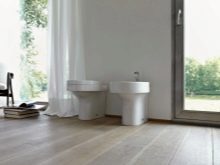
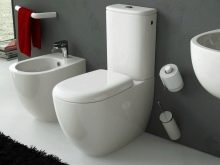
With all the obvious advantages, there are a number of disadvantages that must also be taken into account:
- higher price in comparison with a standard compact;
- repairing such a toilet will be more expensive, and if you do not think about access to the cistern, then the entire wall can be dismantled;
- in case of violations in the work of communications, you will have to disassemble the wall and make repairs again;
- the suspended analogue of the attached one loses in that cleaning of certain zones is difficult.


Varieties
There are quite a few types of toilet bowls of this kind. External characteristics depend solely on the taste of the owners of the apartment and the style of the room. When choosing, it is necessary to take into account the various parameters of the toilet itself and the size of the room. There are more overall and shorter models. For example, you need plumbing to match the type of sewer pipes in the apartment.
By way of water release
- Oblique... Refers to the horizontal type of release. The outlet here is located behind the base or bowl at a downward angle.
- Straight. Suitable for concealed installation, when the drain is hidden in the wall. Can be adapted to oblique positioning by means of an adapter. The horizontal type pipe is parallel to the floor.
- Vertical. Here the exit rushes to the floor, this type is suitable for old housing stock. Also suitable for private homes. The sewage system is located directly under the structure.

Bowl shape
A hidden cistern makes it much easier to care for the plumbing, but does not eliminate the washing process at all. Moreover, the most unhygienic part - the bowl - requires increased attention to keeping it clean. The outside of the bowl can look anything you like, the most important is its internal shape. There are designs that make grooming activities easier, but there are also options that complicate it.
Plate... This form with a shelf in a bowl was once practically the only one. Among its advantages, it was noted that splashes in such a toilet are not formed. A huge minus - flushing needs to be done more abundantly, more often additional cleaning is required.
In addition, water accumulates and stagnates on the shelf, in the depression. And this leads to a change in color, the appearance of a smell.

Funnel... A more perfect type of bowl, it is more hygienic, dirt does not accumulate in it, odors are not formed, since the funnel in the center does not retain water or anything else. This helps to reduce water consumption. Among the minuses is its splattering.

- Semi-shelf. This is the most optimal type of bowl, which combines both previous varieties. Here, a gentle descent of water allows not to linger on what falls on it, while spattering does not occur.

By type of plum
In the attached design, there is no tank in the traditional representation. It is replaced by a flat plastic container, which is hidden behind a false wall in an equipped niche and is sewn up with tiles. Water flows from the tank into the bowl, this can happen in different ways. There are three main types of sinks.
- Shower type... Here water flows in a circle, forming a kind of whirlpool when washed off. Everything is carried down and washed off rather efficiently.
- Cascade type... A less successful variation, in which water flows evenly from one side and washes the bowl.
- Suction type... The most powerful, it is also called "Tornado". In this case, the bowl is filled with water, after which all the contents are drained into the hole.

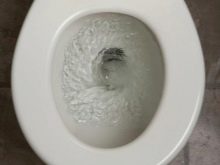

By tank type
The tank in this design is hidden behind the wall, in this regard, the drain system requires compliance with certain installation nuances:
- the floor-standing toilet fits tightly and is installed against the wall;
- hiding in the wall niche of the tank;
- installation of the flush plate.
It is very important to choose a tank that will be connected to the water supply system without problems. The tank itself is quite durable, and it connects in the following ways:
- right or left;
- top or back.


Equally important is the type of fittings that can be connected in different ways:
- by means of a cable-lever;
- by pneumatic type connection.
The two-button design is the most comfortable and economical, since it does not allow to drain the entire tank at once, but to partially use the water. In addition, there are tanks equipped with a stop-drain system. If you accidentally press the button twice, the feed is blocked the second time.

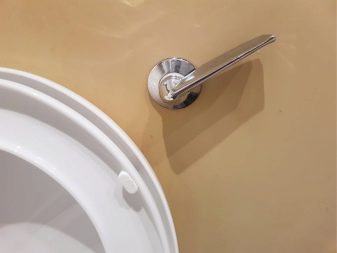


By material of manufacture
Here the choice is the same as in conventional structures: porcelain, sanitary ware, steel, stone. The first two are the most common.
- Porcelain. Quite durable, resistant to damage: both mechanical and chemical. Among the advantages is non-porosity, the smoothness of the surface does not allow moisture to be absorbed, repels dirt. It is easy to clean and keep clean such a toilet. The service life of this species is quite long - more than 50 years with proper care. The price, however, is somewhat more expensive than that of earthenware products.
- Faience. A large number of toilets are made from this material, especially in the budget segment. In appearance, it practically does not differ from porcelain, it is cheaper and no less durable.
Among the minuses is porosity, which, although it is leveled by a smooth coating, still has to be cleaned more often and more thoroughly.


Attached toilets are also made of other materials:
- composite - differs in a variety of colors, since additives that imitate natural stone can be mixed with the main composition;
- a natural stone - beautiful, practical, hygienic, but very expensive, rarely used;
- stainless steel - very practical, hygienic, easy to wash, durability - the highest, most often such models are used in public places.



How to choose?
Choosing a wall-mounted toilet is a very responsible event. In addition to all the above parameters that affect preference, other nuances must be taken into account. First of all, you should understand that this pleasure is not cheap. The better the material and mechanism, the higher the prices. In order to avoid mistakes, you should go to a plumbing store knowing the following points:
- what type of sewer hole in your bathroom, whether it matches the selected model;
- what material of the product, color, design suits the general style of the room;
- it is better to choose a model that matches the size of the bathroom;
- faience, porcelain, steel - more practical, easier to clean;
- choose models with a lever armature of the tank, pneumatic is less durable;
- the size of the toilet should be suitable for the owner's dimensions, weight is of particular importance, not all models are equally comfortable to sit on;
- choose toilets from manufacturers that have proven themselves in the market.




In addition, the additional functions of the attached models can be important. There are options, although not vital, but definitely increasing the level of comfort.
- Microlift. It is a cover system that prevents it from falling and banging loudly against the seat. The principle resembles a door closer system and allows you to lower the lid without worrying about a sharp, noisy fall. So the seat gets rid of damage, crackles.
- Bidet. Toilets with bidet function are becoming more and more popular. Such models are as hygienic as possible. The built-in bidet option can be supplemented with drying, different modes, pressure control and so on.


Installation recommendations
Installation of this type of plumbing does not require additional installations for hanging the bowl, but it has its own characteristics. First of all, this is the installation of a tank in a wall niche. It is fastened with screws or anchors to the wall.After that, the niche is closed in any way.
You can put a main wall or a plasterboard false panel. The decoration is done at the last stage. The wall is sheathed with tiles, plastic panels, wood.



The sewer pipe remains on the outer site of the work. The design with the bowl is connected to it. There are some installation rules to follow:
- first, sewer installation work is carried out, a tank is installed;
- the required equipment height is selected;
- a rigid connection is carried out (for all methods of connection to the sewer);
- the connection is strengthened with a compound with hermetic properties;
- give up corrugations, flexible type liners: their service life is much shorter;
- take into account how the pipes are located so that the liner does not leak, different levels can affect this factor negatively;
- choose a double type button for economical water consumption;
- provide hatches for access to communications in order to avoid dismantling in the event of a breakdown;
- lay out the tiles starting from the push-button hatch.
The installation of a concealed cistern for a floor standing toilet is shown below.








